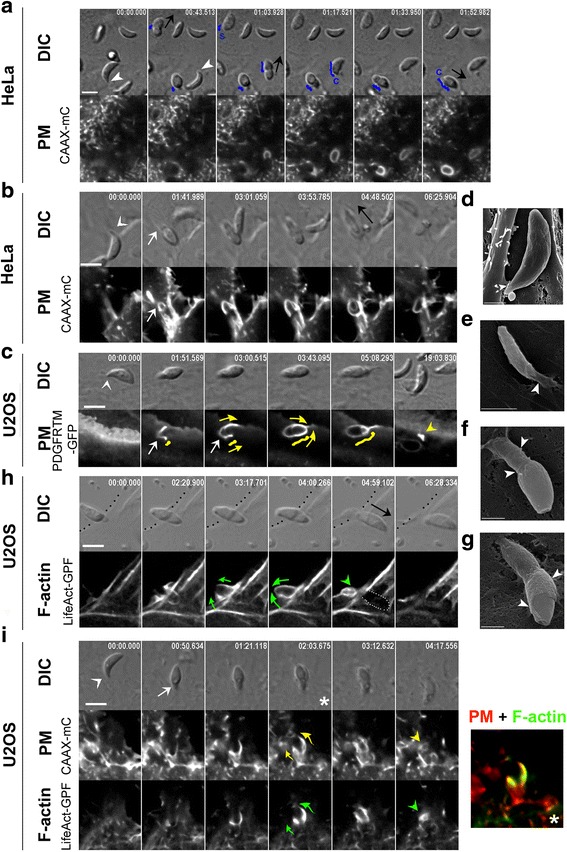Fig. 2.

Real-time tracking of the host cell PM and cortical actin demonstrate that MyoA- but not MyoC-deficient tachyzoites are pushed into host cells through actin-powered PM protrusions. a–c, h, i Time lapses showing differential interference contrast (DIC) and fluorescent characteristic sequences of interaction between (a) ΔMyoC (n = 216) or (b, c, h, i) ΔMyoA (n = 300) tachyzoites and (a, b) HeLa cells that stably express the PM targeting domain CAAX-mCherry (CAAX-mC) or (c, h, i) U2OS cells. c U2OS cells transiently express the PM reporter PDGF trans-membrane domain (PDGFTM) coupled to GFP or (h) the F-actin binding peptide LifeAct coupled to GFP (LifeAct-GFP), or (i) transiently co-express the PDGFTM PM marker coupled to mCherry (mC) and LifeAct, coupled to GFP. Note the extruded position of the conoid prior to the contact with the host cell PM (a–c, i; white arrowheads) and the forward displacement of the tachyzoite (a, b, h; black arrows). a Trajectories (blue lines) of the constriction site (i.e., the TJ) with time reveal that ΔMyoB/C tachyzoites enter their host cells using a typical static or capped TJ scenario. In contrast, tracking of the PM (b, c, i) and cortical F-actin (h, i) dynamics reveals progressive encircling of the ΔMyoA tachyzoites by PM ruffles that are supported by F-actin (yellow and green arrows, respectively). Note that retraction of the PM ruffles together with F-actin disassembly follow zoite internalization as indicated with yellow and green arrowheads, respectively. i Right frame shows the overlap between PM and actin remodeling for the zoomed frame of the time lapse showing half in–half out zoite labeled with a white star. All scale bars: 5 μm. d–g SEM micrographs showing (d) RH-MyoA+, (e) lox-MyoA (MyoA+), (f, g) ΔMyoA (MyoA-) interacting with host cells. Note (d, e) the host cell spatially restricted “glove-like” PM protrusions around the zoite apex (white arrowheads) and (f, g) the thin host cell PM long sheath that constrains a third of the zoite and expands over its body. Scale bars: 1 μm (d, f, g) and 2 μm (e)
